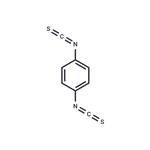Bitoscanate is a colorless to beige, odorless,crystalline compound. Molecular weight=192.3; Freezing/Melting point=132℃. Hazard Identification (based onNFPA-704 M Rating System): Health 2, Flammability 1,Reactivity 0.
off-white to yellow to beige-grey crystalline
Those engaged in the manufacture,
formulation and application of this anthelmintic
compound.
Incompatibilities: In general, keep away from strong oxidizers,
moisture, strong acids, strong bases. This is a thiocyanate
compound. Violent reactions may occur upon contact
with chlorates (potassium chlorate, sodium chlorate),
nitrates, nitric acid; organic peroxides.
It is used in the treatment of?hookworms.
Reagent for solid-phase sequencing.
ChEBI: Bitoscanate is a member of benzenes.
Odorless colorless crystals. Melting point 132°C.
1,4-PHENYLENE DIISOTHIOCYANATE reacts readily with amines [Noller]. These reactions may generate significant amounts of heat . Emits very toxic fumes of nitrogen oxides and sulfur oxides when heated to decomposition [EPA, 1998].
1,4-PHENYLENE DIISOTHIOCYANATE is highly toxic if ingested. It is a central nervous system and gastrointestinal toxin in humans.
When heated to decomposition, 1,4-PHENYLENE DIISOTHIOCYANATE emits very toxic fumes of nitrogen oxides and sulfur oxides.
reagent type: cross-linking reagent
Poison by ingestion and intraperitoneal routes. Human systemic effects by ingestion: hallucinations, nausea. When heated to decomposition it emits very toxic fumes of NOx,CN,and SOx.See also THIOCYANATES
Those engaged in the manufacture,
formulation and application of this anthelmintic
compound.
Incompatibilities: In general, keep away from strong oxidizers,
moisture, strong acids, strong bases. This is a thiocyanate
compound. Violent reactions may occur upon contact
with chlorates (potassium chlorate, sodium chlorate),
nitrates, nitric acid; organic peroxides.
If this chemical gets into the eyes, remove anycontact lenses at once and irrigate immediately for at least15 min, occasionally lifting upper and lower lids. Seekmedical attention immediately. If this chemical contactsthe skin, remove contaminated clothing and wash immediately with soap and water. Seek medical attention immediately. If this chemical has been inhaled, remove fromexposure, begin rescue breathing (using universal precautions, including resuscitation mask) if breathing hasstopped and CPR if heart action has stopped. Transferpromptly to a medical facility. When this chemical hasbeen swallowed, get medical attention. Give large quantities of water and induce vomiting. Do not make an unconscious person vomit. For cyanide poisoning, use amylnitrate capsules if symptoms develop. All area employeesshould be trained regularly in emergency measures for cyanide poisoning and in CPR. A cyanide antidote kit shouldbe kept in the immediate work area and must be rapidlyavailable. Kit ingredients should be replaced every 1� 2years to ensure freshness. Persons trained in the use of thiskit, oxygen use, and CPR must be quickly available.
Color Code—Green: General storage may be used.Store in tightly closed containers in a cool, well-ventilatedarea. Store under inert gas; moisture sensitive.
UN2811 Toxic solids, organic, n.o.s., Hazard
Class: 6.1; Labels: 6.1—Poisonous materials, Technical
Name Required.
Purify bitoscanate by recrystallisation from AcOH, pet ether (b 40-60o), Me2CO or aqueous Me2CO. [van der Kerk et al. Recl Trav Chim Pays-Bas 74 1262 1955, Leiber & Slutkin J Org Chem 27 2214 1962, Beilstein 13 IV 174.]
Incompatible with oxidizers (chlorates,
nitrates, peroxides, permanganates, perchlorates, chlorine,
bromine, fluorine, etc.); contact may cause fires or explosions.
Keep away from alkaline materials, strong bases,
strong acids, oxoacids, epoxides.



